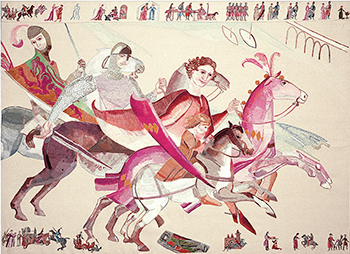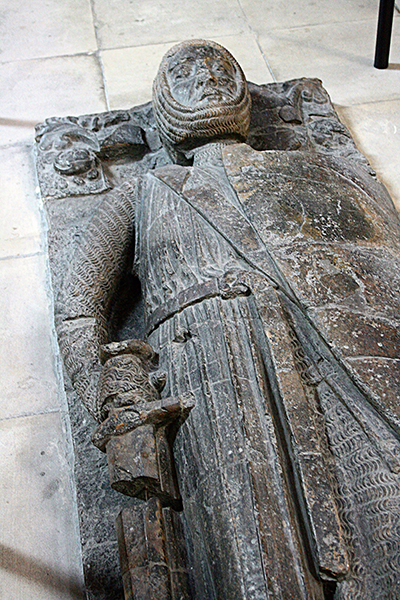The remnants of William Marshal’s lordship in Leinster today
Published in Features, Issue 4 (July/August 2021), Volume 29By John Marshall
What did William Marshal ever do for us? Described by renowned historian A.J. Otway-Ruthven as ‘perhaps the ablest and most remarkable of all the Norman leaders’, Marshal (d. 1219) first set foot in Ireland in 1200. He obtained the lordship of Leinster through his marriage to Isabel de Clare, Strongbow’s daughter, in 1189. From his headquarters at the site of present-day Kilkenny Castle (of which three towers remain) he reformed the administration of Leinster into four counties—Kildare, Wexford, Kilkenny and Carlow. Marshal’s longest stay in Ireland was from 1207 to 1213, during which he carried out most of his constructions. These buildings ranged from defensive to ecclesiastical properties, many of which remain in Leinster today and are enjoyed by tourists and locals alike.
Kilkenny
Before Marshal reformed the lordship of Leinster, he united the town of Kilkenny—previously divided into two towns, one centred around the former church of St Canice and the other around St Patrick’s church, Donoughmore—by establishing the present-day High Street and Parliament Street, which together constituted High Town. This led to the division of the boroughs of Kilkenny town into Irish Town (around St Canice’s) and High Town, representing the Anglo-Norman borough. The stone fortress of Kilkenny Castle was completed by 1213 on the site of a wooden fortification previously constructed by Strongbow and, once completed, it housed Marshal’s wife, Isabel. Its close proximity to the banks of the River Nore allowed for control of the waterways. In addition to the heavily fortified castle, Marshal placed knights in fiefs (estates) surrounding Kilkenny. To the south they held the lands of Thomastown, Kells, Mallardstown and Earlstown; to the east they held Gowran; to the west lay the castle and demesne of Callan; and to the north lay the military outposts of Castlecomer, Offerland and Aghaboe (which were the most vulnerable as a result of being the least settled). Marshal’s well-defended administrative capital of Kilkenny would benefit greatly from the trading port of New Ross.
New Ross

Above: Panel 7 of the Ros Tapestry, ‘William Marshal—The Flower of Chivalry’. (Ros Tapestry, New Ross, Co. Wexford)
The economic hub of William Marshal’s lordship was the town of Ros Mhic Treoin (New Ross, Co. Wexford). The plan to place such importance on New Ross was evident early in his lordship with Marshal’s initial substantial investment of 506 burgages (tenure by which land was held in return for service or annual rent), compared with the allocation of only 160 burgages each to Carlow and Ferns, along with the construction of a bridge across the River Barrow. The port of New Ross was granted a royal charter in 1207 and flourished over the following centuries, even rivalling the king of England’s port of Waterford. William Marshal is still remembered in New Ross, where the Ros Tapestry exhibition has produced several works commemorating his legacy in the area. Panel 7 (above) describes Marshal as ‘The Flower of Chivalry’ and portrays various events in his life.
The port of New Ross largely determined Marshal’s actions in Leinster, such as the construction of a circular turret from local limestone on the extremity of the Hook peninsula at the entrance to Waterford harbour in the early thirteenth century. The turret acted as a navigational beacon to guide ships to the port at New Ross and still stands today as the Hook lighthouse, Co. Wexford, a popular year-round tourist attraction. It is the second-oldest operating lighthouse in the world (after the Tower of Hercules, Spain). To the north-east of Hook Head, Marshal founded a town at Clonmines in the Bannow Bay area of County Wexford, which offered a sheltered winter port as an alternative to New Ross.

Above: Effigy of William Marshal at his burial place, Temple Church, London.
Riverine fortifications
Marshal’s main priority during his lordship was ensuring the security of the port of New Ross, which meant controlling those riverine routes. This was accomplished by the establishment of fortifications along the waterways, resulting in Marshal’s eventual control of the rivers Slaney, Barrow and Nore. The castles not only were constructed for similar purposes but also followed a similar design—the towered keep, which is evident at the ruins of Marshal castles at Ferns (Co. Wexford) and Carlow. The fortress at Ferns is the most renowned of these castles, with a considerable amount known about the fortification owing to excavations in recent years. Leask characterised Ferns Castle as having the finest towered keep in Ireland, in addition to having the most perfect chapel of any Irish castle.
With the riverine routes secured, Marshal also took control of the obtrusive castle on the rock of Dunamase, Co. Laois. Here, on the site of a pre-existing fort, Meiler FitzHenry had constructed an Anglo-Norman fortification near the end of the twelfth century. Although it occupied a naturally defensive location on such an elevated position, Marshal reinforced the more vulnerable east and south-east sides by building numerous loops in the curtain walls of the lower ward and inner barbican (fortified outpost or gateway). Dunamase housed his military power and administration for north-western Leinster. The ruins still standing today are impressive, and they give an idea of the commanding position of the fortress, with views spanning the surrounding countryside.
Abbeys
In addition to his construction of towns and fortifications, Marshal also granted lands for the building of two impressive abbeys. During his first visit to Leinster in 1200 he had established the Cistercian abbey at Tintern, Wexford (above/below). This was named after an abbey at the village of Tintern in Monmouthshire, Wales, which had been built in 1131 by Walter de Clare, his wife’s great-grand-uncle. Tintern Abbey has been adapted over the centuries. It was used as living quarters after 1541 by the Colclough family, who had obtained ownership thanks to their support for the dissolution of the monasteries under Henry VIII, and they resided there until the 1960s. It is now managed by the Office of Public Works, with guided tours and numerous walks available around the grounds. The other abbey Marshal founded was Duiske Abbey in Graiguenamanagh, Co. Kilkenny. Built at the beginning of the thirteenth century, it was also a Cistercian monastery. Today, it acts as the parish church of Graiguenamanagh and also houses concerts, though its medieval characteristics can still be perceived.
Irish displaced
William Marshal’s development of Leinster came at the expense of the original Gaelic inhabitants, who were left to choose between the carrot and the stick: tenantry under the Anglo-Norman overlord or migration to an area either of little value to the Anglo-Normans or where Gaelic defence could easily be maintained. In Leinster there were examples of both. Undoubtedly a far greater number of the Irish reached an accommodation with Marshal and the lordship of Leinster, and some of them profited considerably thereby.
One of the Gaelic families in Leinster that maintained the best relations with the Anglo-Normans were the Mac Murchadas. They were almost certainly related to Isabel Marshal, whose mother was a Mac Murchada. They maintained influence in the territory of the uplands and woods of north Wexford and Carlow, and their cooperation even extended to offering support in the suppression of Gaelic revolts.
The decision of whether to conform or not became a dividing issue for some Gaelic clans. Two pertinent examples were the Uí Fáeláins (O’Byrnes), who had their original seat at Naas, and the Uí Muiredaig (O’Tooles), who originally controlled south Kildare. Some O’Byrnes settled in north Carlow or under the FitzGerald family at Naas, even taking Gerald as a forename in later generations. Some O’Tooles settled under the de Riddlesford family around their manor of Kilkea, Co. Kildare, and even began to adopt the forename Walter within a few generations. Those not prepared to conform migrated to the Wicklow mountains, which became known as terre de guerre (land of war), with the O’Byrnes controlling the east and the O’Tooles controlling the west.
Two other Gaelic clans were severely displaced by the development of the Leinster lordship: the Mac Gillapatricks and the Ui Failge. The Mac Gillapatricks originally held sway over Osraige, which is roughly marked by the present diocese of Ossory. Owing to Anglo-Norman encroachment, they lost most of their territory, only retaining the northern portion by the Slieve Bloom Mountains. The Ui Failge (O’Connor Falys) originally had their royal centre at Rathangan, Co. Kildare, but they were pushed westwards into bogland. Although their power base was greatly reduced, they frequently raided Kildare town.
Legacy
Although William Marshal had spent only a short time in Ireland by the time of his death in 1219, he had achieved quite a lot. He had consolidated the administration of Leinster and constructed a flourishing port at New Ross which was exporting wool and hides, while large quantities of wheat, cheese and other provisions also passed through the town en route to Norman armies in Wales. Following his death, Leinster experienced a period of peace and prosperity in the 1220s, when an intensive settlement programme was implemented by his son William. The deaths of Marshal’s five sons without legitimate heirs led to the division of his holdings amongst his descendants in 1247. This lack of unity provided the displaced Gaelic clans with an opportunity to reclaim territory from the 1270s onwards. The O’Byrnes and O’Tooles emerged from the Wicklow mountains, and even Mac Murchada resistance was reborn under Art. Nonetheless, the legacy of William Marshal remains intact today throughout Leinster in the impressive castles and abbeys that welcome history-appreciating locals and tourists alike.
John Marshall is a Ph.D student at Trinity College, Dublin, researching the Leinster lordship and its place within the Marshal transnational holdings.
FURTHER READING
J. Bradley, C. Ó Drisceoil & M. Potterton (eds), William Marshal and Ireland (Dublin, 2017).
B. Colfer, Arrogant trespass: Anglo-Norman Wexford 1169–1400 (Wexford, 2002).
H.G. Leask, Irish castles (Dundalk, 1941).
A.J. Otway-Ruthven, A history of medieval Ireland (London, 1968).
















